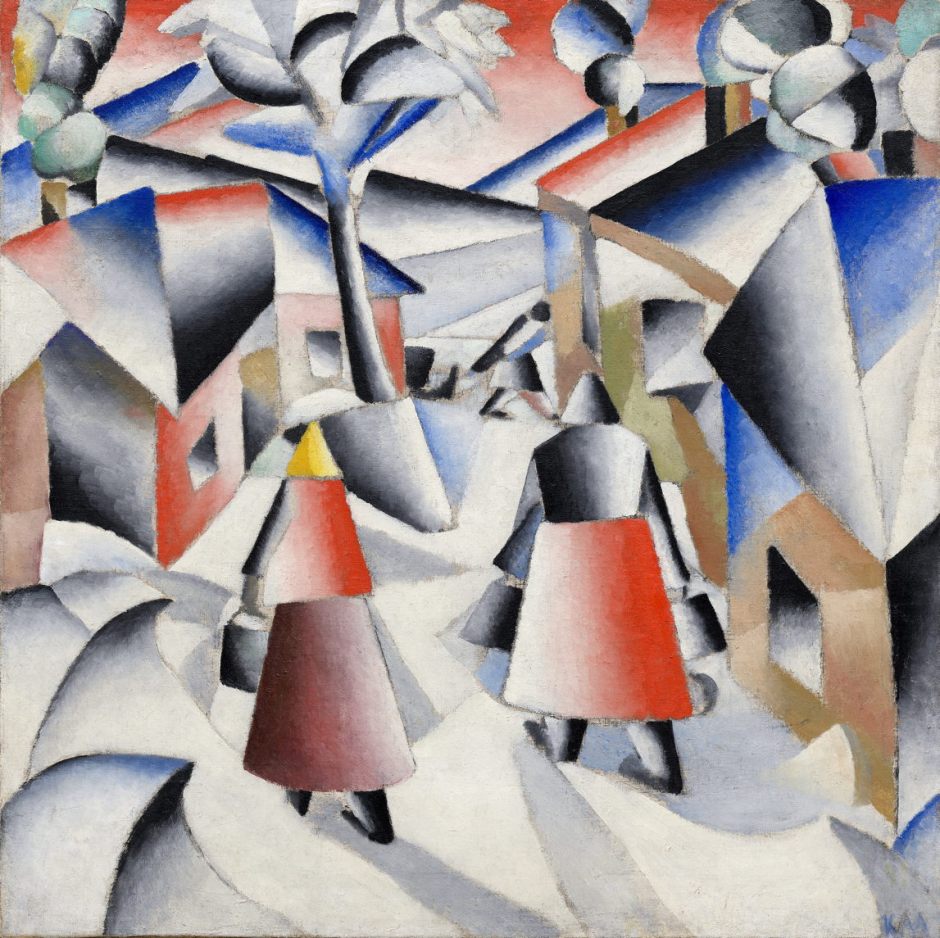Some of those painters who were born and started their training in Ukraine don’t fit easily with any single national attribution. This week’s artist, known in Ukraine as Kazymyr Malevych (1879–1935), or by the Polish version of Kazimierz Malewicz, has been claimed as a leading Russian artist, although he may have seen himself as more Polish, through descent. As he was brought up to speak all three languages, Polish, Ukrainian and Russian, it’s perhaps best to view his work as coming from all three cultures.
Malevych was born near Kyiv, and during his childhood moved around Ukraine with his family. In 1895-96 he started studying art in Kyiv, then moved to Kursk, in Russia, close to the northern border of Ukraine, where he lived until he went to study at the Moscow School of Painting, Sculpture and Architecture in 1904. He completed his studies there in 1910, and quickly became involved with modernist groups, exhibiting in Saint Petersburg and Moscow. His work was shown alongside those of Oleksandra Ekster, Oleksandr Arkhypenko, and Volodymyr Burliuk.

His early gouache Self-portrait from 1910-11 is perhaps his best-known work from this period. Its unusual background of nude figures may refer to his recent training in Moscow.

Bather from 1911 is another early gouache.

He painted Peasant Woman with Buckets and Child in 1911-12.
In 1912, he described his work as being Cubo-Futurist, and designed stage sets in Saint Petersburg.

Morning in the Village after Snowstorm (1912) show his rapid development of Cubist style.

He also painted Taking in the Rye II in 1912.

By the following year, his Cubism had developed further, as seen in this painting of a Bureau and Room from 1913.
In 1915, Malevych published his manifesto From Cubism to Suprematism, marking his own move to Suprematism. He also worked in the folk art centre of Verbovka, near Kyiv.

Painterly Realism of a Football Player – Color Masses in the 4th Dimension from 1915 is one of his early Suprematist works. He later came to focus on individual elements, most notably the black square.
Malevych had a succession of important teaching posts after the 1917 October Revolution. In 1919 he taught at the Vitebsk Practical Art School in Belarus alongside Marc Chagall, then in Leningrad from 1922-27. During the 1920s, he refused to adopt the official idealised style of Socialist Realism, but was tolerated by the Soviet state.
Some accounts of his paintings report that, like others of his time, his style as a student was Impressionist, and then made the journey through Cubism and Cubo-Futurism to Suprematism. In the small selection of his paintings that I have examined, they are most Impressionist after 1920 and towards the end of his career.

For example, he painted this House in a Yard in the 1920s.

In the late 1920s, he painted this Winter Landscape.
In 1927, Malevych was given a hero’s welcome when he visited Warsaw in Poland. From there he went on to Berlin and Munich, where he attained international recognition in a major retrospective. Fortunately, he left most of the paintings he had exhibited there in Germany, rather than returning them to Russia.
In 1928-30 he taught at the Kyiv Art Institute, at a time when it was at the heart of progressive art education in Ukraine. There he established the Research Workshop of Experimental Art, to which he commuted once a month from Leningrad. Among his colleagues teaching there was Oleksandr Bohomazov. From there he published a series of influential articles on the theory of art, and in 1930 his last solo exhibition was organised in Kyiv.
When he was considering moving permanently to Kyiv in 1930, he was among those abruptly sacked from their teaching posts for political reasons. Later that year, he was arrested by the KGB when he was in Leningrad, interrogated and threatened with execution, before he was released at the end of the year.

He painted this Portrait of Una in 1934, shortly before his death.
Malevych died in Leningrad (now Saint Petersburg) on 15 May 1935, of cancer. His work was subsequently neglected in Russia, then he was later championed as a pioneer of the Russian avant garde. He has also been claimed as a Polish artist, and as a key figure in the Ukrainian avant garde. As with so many other artists, it was only long after his death that he has become fully appreciated.
References
Andrey Kurkov and others (2022) Treasures of Ukraine, A Nation’s Cultural Heritage, Thames & Hudson. ISBN 978 0 500 02603 8.
Konstantin Akinsha and others (2022) In the Eye of the Storm, Modernism in Ukraine 1900-1930s, Thames & Hudson. ISBN 978 0 500 29715 5.

